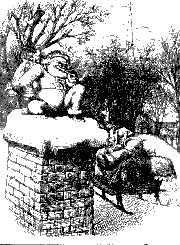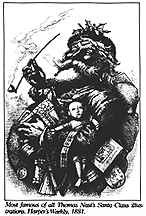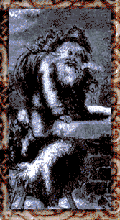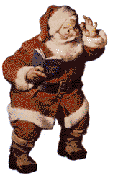THE HISTORY OF SANTA CLAUS
A TRADITION OF BENEVOLENCE
In a well known story illustrating St, Nicholas' benevolence, we find two of the basic principles of the holiday spirit - giving to others and helping the less fortunate - as well as the tradition of hanging stockings by the fireplace.
According to this legend, there were three Italian maidens whose families had fallen on hard times. Because their father could not afford the dowries necessary for them to marry, he was considering selling one of his daughters into slavery to get dowries for the other two. When the good saint heard of the family's plight, he went to their home late one night and anonymously tossed three bags of gold down the chimney. Miraculously, a bag fell into each of the sisters stockings, were hanging by the fire to dry. His kindhearted gift made it possible for all three sisters to marry.
A variation of this story is that as each girl was ready to wed, St. Nicholas came in the middle of the night when no one could see him and tossed a bag of gold through an open window into her stocking. The idea of gifts being delivered through an open window may have begun as a way to explain how Santa enters homes that have no chimney.
PATRON SAINT
Because of his wisdom and sensitivity, many groups claimed St. Nicholas as their patron saint. Children, orphans, sailors, and even thieves often prayed to the compassionate saint for guidance and protection. Entire countries, including Russia and Greece, also adopted him as their patron saint, as well as students and pawnbrokers.
Throughout his life, St. Nicholas tried to help others while inspiring the to imitate his virtues. Legends of his unselfish giving spread all over Northern Europe, and accounts of his heroic deeds blended with regional folklore. Eventually, the image of the stately saint was transformed onto an almost mystical being, one known for rewarding the good and punishing the bad.
The date of his death, December 6th, was commemorated with an annual feast, which gradually came to mark the beginning of the medieval Christmas season. On St. Nicholas' Eve, youngsters would set out food for the saint, straw for his horses and schnapps for his attendant. The next morning, obedient children awoke to find their gifts replaced with sweets and toys, found their offering untouched , along with a rod or a bundle of switched. St. Nicholas' Day is still observed in many countries, and gifts are exchanged in honor of the spirit of brotherhood and charity that he embodied.
THE MAKING OF SANTA CLAUS
After the Protestant Reformation in the sixteenth century, the feasting and veneration of Catholic saints were banned. But people had become accustomed to the annual visit from their gift-giving saint and didn't want to forget the purpose of the holiday. So in some countries, the festivities of St. Nicholas' Day were merged with Christmas celebrations, and although the gift-bearer took on new, non-religious forms, he still reflected the saints generous spirit.
In Germany, he appeared as Weihnachtsmann, in England as Father Christmas, and in France, as Pèrè Noël, who left small gifts in the children's shoes.
In the areas where St. Nicholas was still portrayed as the gift-bearer, a host of other characters developed to be his assistants. Two of his most well-known helpers were Knecht Ruprecht and the Belsnickle. Depending on the local tradition, they were either attendants to St. Nicholas or gift-bears themselves, but in all cases, both were fearsome characters, brandishing rods and switches. It was not only their dusty to reward good children but also to reprove children who were naughty and couldn't recite their prayers.
Knecht Ruprecht (meaning Servant Rupert) was also by other names such as Black Peter (so called because he delivered the presents down the chimney for St. Nicholas and became blackened with soot).
In some places, the images, of Knecht Ruprecht and St. Nicholas merged to form Ru Klaus (meaning Rough Nicholas - so named because of his rugged appearance), Aschen Klaus (meaning Ash Nicholas - because he carried a sack of ashes as well as a bundle of switches), and Pelznickle (meaning Furry Nicholas - referring to his fur clad appearance).
Not all of St. Nicholas' companions were frightening. In fact, the Christkindl (meaning Christ Child) was thought to accompany him in many countries. Often portrayed by a fair-haired young girl, this angelic figure was sometimes the gift-bearer too.
SANTA IN AMERICA
Immigrants to the New World brought along their various beliefs when they crossed the Atlantic. The Scandinavians introduced gift-giving elves, the Germans brought not only their Belsnickle and Chistkindle but also their decorated trees and the Irish contributed the ancient Gaelic custom of placing a lighted candle in the window.
In the 1600's, the Dutch presented Sinterklaas (meaning St. Nicholas) to the colonies. In their excitement, many English-speaking children uttered the name so quickly that Sinterklaas sounded like Santy Claus. After years of mispronunciation, the name evolved into Santa Claus.
In 1808, American author Washington Irving created a new version of old St. Nick. This one rode over the treetops in a horse drawn wagon "dropping gifts down the chimneys of his favorites." In his satire, Diedrich Knickerbocker's History of New York from the Beginning of the World to the End of the Dutch Dynasty, Irving described Santa as a jolly Dutchman who smoked a long stemmed clay pipe and wore baggy breeches and a broad brimmed hat. Also, the familiar phrase, "...laying his finger beside his nose...," first appeared in Irving's story.
That phrase was used again in 1822 in the now-classic poem by Dr. Clement Clarke Moore, "A Visit from St. Nicholas," more commonly know as "The Night Before Christmas." His verse gave an Arctic flavor to Santa's image when he substituted eight tiny reindeer and a sleigh for Irving's horse and wagon. It is Moore's description of Santa that we most often think of today: "He had a broad face, and a little round belly, that shook, when he laughed, like a bowl full of jelly."
Up to this point, Santa's physical appearance and the color of his suit were open to individual interpretation. Then in 1863, Thomas Nast, a German immigrant, gave us a visual image of the cheerful giver that was to later become widely accepted.
When Nast was asked to illustrate Moore's charming verse for a book of children's poems, he gave us a softer, kinder Santa who was still old but appeared less stern than the ecclesiastical St. Nicholas. He dressed his elfin figure in red and endowed him with human characteristics. Most important of all, Nast gave Santa a home at the North Pole. For twenty-three years, his annual drawings in Harpers Weekly magazine allowed Americans to peek into the magical world of Santa Claus and set the stage for the shaping of today's merry gentleman.
Artist Haddon Sundblom added the final touches to Santa's modern image. Beginning in 1931, his billboard and other advertisements for Coca Cola-Cola featured a portly, grandfatherly Santa with human proportions and a ruddy complexion. Sunblom's exuberant, twinkle-eyed Santa firmly fixed the gift-giver's image in the public mind.
St। Nicholas' evolution into today's happy, larger-than-life Santa Claus is a wonderful example of the blending of countless beliefs and practices from around the world. This benevolent figure encompasses all the goodness and innocence of childhood. And because goodness is his very essence, in every kindness we do, Santa will always be remembered.
(OR)


"American Origins: (As sent to me by Brian Dodd)
Quote from ENCARTA 95
The American version of the Santa Claus figure received its inspiration and its name from the Dutch legend of Sinter Klaas, brought by settlers to New York in the 17th century.
As early as 1773 the name appeared in the American press as "St. A Claus," but it was the popular author Washington Irving who gave Americans their first detailed information about the Dutch version of Saint Nicholas. In his History of New York, published in 1809 under the pseudonym Diedrich Knickerbocker, Irving described the arrival of the saint on horseback (unaccompanied by Black Peter) each Eve of Saint Nicholas.
 This Dutch-American Saint Nick achieved his fully Americanized form in 1823 in the poem A Visit From Saint Nicholas more commonly known as The Night Before Christmas by writer Clement Clarke Moore. Moore included such details as the names of the reindeer; Santa Claus's laughs, winks, and nods; and the method by which Saint Nicholas, referred to as an elf, returns up the chimney. (Moore's phrase "lays his finger aside of his nose" was drawn directly from Irving's 1809 description.)
This Dutch-American Saint Nick achieved his fully Americanized form in 1823 in the poem A Visit From Saint Nicholas more commonly known as The Night Before Christmas by writer Clement Clarke Moore. Moore included such details as the names of the reindeer; Santa Claus's laughs, winks, and nods; and the method by which Saint Nicholas, referred to as an elf, returns up the chimney. (Moore's phrase "lays his finger aside of his nose" was drawn directly from Irving's 1809 description.)
 The American image of Santa Claus was further elaborated by illustrator Thomas Nast, who depicted a rotund Santa for Christmas issues of Harper's magazine from the 1860s to the 1880s. Nast added such details as Santa's workshop at the North Pole and Santa's list of the good and bad children of the world. A human-sized version of Santa Claus, rather than the elf of Moore's poem, was depicted in a series of illustrations for Coca-Cola advertisements introduced in 1931. In modern versions of the Santa Claus legend, only his toy-shop workers are elves. Rudolph, the ninth reindeer, with a red and shiny nose, was invented in 1939 by an advertising writer for the Montgomery Ward Company.
The American image of Santa Claus was further elaborated by illustrator Thomas Nast, who depicted a rotund Santa for Christmas issues of Harper's magazine from the 1860s to the 1880s. Nast added such details as Santa's workshop at the North Pole and Santa's list of the good and bad children of the world. A human-sized version of Santa Claus, rather than the elf of Moore's poem, was depicted in a series of illustrations for Coca-Cola advertisements introduced in 1931. In modern versions of the Santa Claus legend, only his toy-shop workers are elves. Rudolph, the ninth reindeer, with a red and shiny nose, was invented in 1939 by an advertising writer for the Montgomery Ward Company.
In looking for the historical roots of Santa Claus, one must go very deep in the past. One discovers that Santa Claus as we know him is a combination of many different legends and mythical creatures.
The basis for the Christian-era Santa Claus is Bishop Nicholas of Smyrna (Izmir), in what is now Turkey. Nicholas lived in the 4th century A.D. He was very rich, generous, and loving toward children. Often he gave joy to poor children by throwing gifts in through their windows.
 The Orthodox Church later raised St. Nicholas, miracle worker, to a position of great esteem. It was in his honor that Russia's oldest church, for example, was built. For its part, the Roman Catholic Church honored Nicholas as one who helped children and the poor. St. Nicholas became the patron saint of children and seafarers. His name day is December 6th.
The Orthodox Church later raised St. Nicholas, miracle worker, to a position of great esteem. It was in his honor that Russia's oldest church, for example, was built. For its part, the Roman Catholic Church honored Nicholas as one who helped children and the poor. St. Nicholas became the patron saint of children and seafarers. His name day is December 6th.
![]() In the Protestant areas of central and northern Germany, St. Nicholas later became known as der Weinachtsmann. In England he came to be called Father Christmas. St. Nicholas made his way to the United States with Dutch immigrants, and began to be referred to as Santa Claus.
In the Protestant areas of central and northern Germany, St. Nicholas later became known as der Weinachtsmann. In England he came to be called Father Christmas. St. Nicholas made his way to the United States with Dutch immigrants, and began to be referred to as Santa Claus.
 In North American poetry and illustrations, Santa Claus, in his white beard, red jacket and pompom-topped cap, would sally forth on the night before Christmas in his sleigh, pulled by eight reindeer, and climb down chimneys to leave his gifts in stockings children set out on the fireplace's mantelpiece.
In North American poetry and illustrations, Santa Claus, in his white beard, red jacket and pompom-topped cap, would sally forth on the night before Christmas in his sleigh, pulled by eight reindeer, and climb down chimneys to leave his gifts in stockings children set out on the fireplace's mantelpiece.
Children naturally wanted to know where Santa Claus actually came from. Where did he live when he wasn't delivering presents? Those questions gave rise to the legend that Santa Claus lived at the North Pole, where his Christmas-gift workshop was also located.
In 1925, since grazing reindeer would not be possible at the North Pole, newspapers revealed that Santa Claus in fact lived in Finnish Lapland. "Uncle Markus", Markus Rautio, who compared the popular "Children's hour" on Finnish public radio, revealed the great secret for the first time in 1927: Santa Claus lives on Lapland's Korvatunturi - "Ear Fell"
The fell, which is situated directly on Finland's eastern frontier, somewhat resembles a hare's ears - which are in fact Santa Claus's ears, with which he listens to hear if the world's children are being nice. Santa has the assistance of a busy group of elves, who have quite their own history in Scandinanvian legend.
 Over the centuries, customs from different parts of the Northern Hemisphere thus came together and created the whole world's Santa Claus - the ageless, timeless, deathless white-bearded man who gives out gifts on Christmas and always returns to Korvatunturi in Finnish Lapland.
Over the centuries, customs from different parts of the Northern Hemisphere thus came together and created the whole world's Santa Claus - the ageless, timeless, deathless white-bearded man who gives out gifts on Christmas and always returns to Korvatunturi in Finnish Lapland.
 Since the 1950s, Santa has happily sojourned at Napapiiri, near Rovaniemi, at times other than Christmas, to meet children and the young at heart. By 1985 his visits to Napapiiri had become so regular that he established his own Santa Claus Office there. He comes there every day of the year to hear what children want for Christmas and to talk with children who have arrived from around the world. Santa Claus Village is also the location of Santa's main Post Office, which receives children's letters from the four corners of the world.
Since the 1950s, Santa has happily sojourned at Napapiiri, near Rovaniemi, at times other than Christmas, to meet children and the young at heart. By 1985 his visits to Napapiiri had become so regular that he established his own Santa Claus Office there. He comes there every day of the year to hear what children want for Christmas and to talk with children who have arrived from around the world. Santa Claus Village is also the location of Santa's main Post Office, which receives children's letters from the four corners of the world.


No comments:
Post a Comment